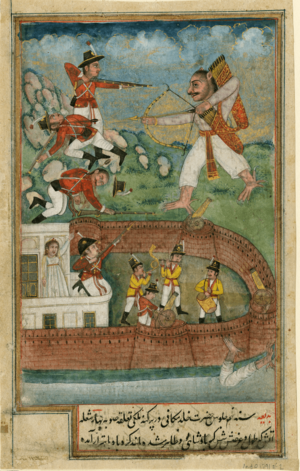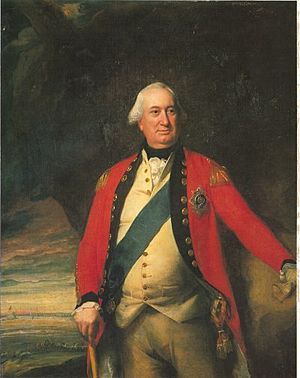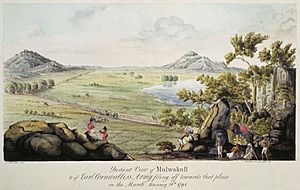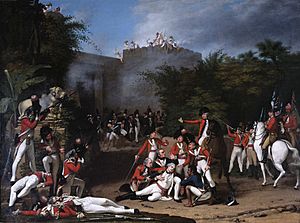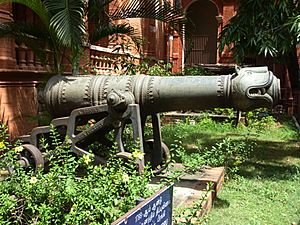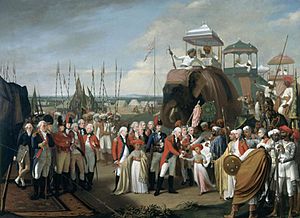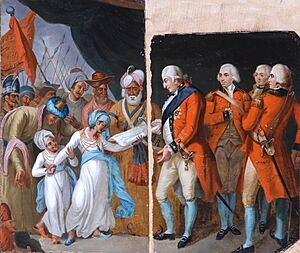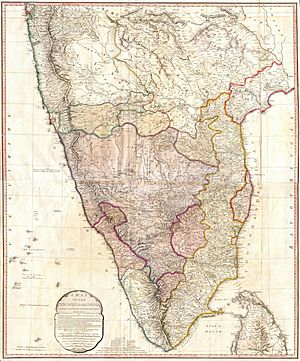Third Anglo-Mysore War facts for kids
Quick facts for kids Third Anglo-Mysore War |
|||||||||
|---|---|---|---|---|---|---|---|---|---|
| Part of the Anglo-Mysore Wars | |||||||||
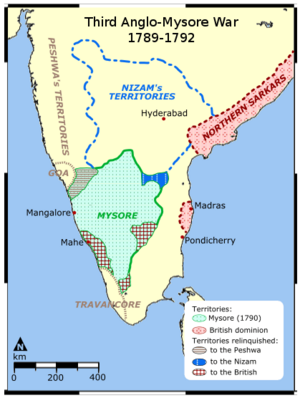 A map of the war theatre |
|||||||||
|
|||||||||
| Belligerents | |||||||||
|
|
||||||||
| Commanders and leaders | |||||||||
|
|
||||||||
The Third Anglo-Mysore War was a big fight in South India between 1790 and 1792. It involved the Kingdom of Mysore and a group of allies. These allies were the British East India Company, the Kingdom of Travancore, the Maratha Empire, and the Nizam of Hyderabad. This war was the third of four major conflicts known as the Anglo-Mysore Wars.
Contents
How the War Started
Past Conflicts with Mysore
Before this war, Tipu Sultan and his father, Hyder Ali, had already fought the British East India Company twice. The First Anglo-Mysore War in the 1760s ended with no clear winner. Both sides agreed to help each other if they faced future attacks. However, the British didn't help Mysore when the Maratha Empire attacked. This made Hyder Ali dislike the British.
In 1779, the British took Mahé, a port that supplied Mysore with military goods. Tipu's father had protected this port. This led to the Second Anglo-Mysore War. This war ended with the Treaty of Mangalore in 1784. This treaty was seen as very bad for the British East India Company. Tipu Sultan took over Mysore after his father died in 1782. He really disliked the British and wanted to fight them again. He even refused to free British prisoners, which was part of the treaty.
New Leaders and Alliances
In 1786, Charles Cornwallis became the top British official in India. He wanted to make sure the Marathas and Hyderabad would either help the British or stay neutral if there was another war with Mysore.
Steps Leading to War
In 1788, the British Company took control of the Guntur district. This area was close to Mysore. In return, the British gave the Nizam of Hyderabad two groups of their soldiers. This meant British troops were closer to Mysore and the Nizam would support them in a fight.
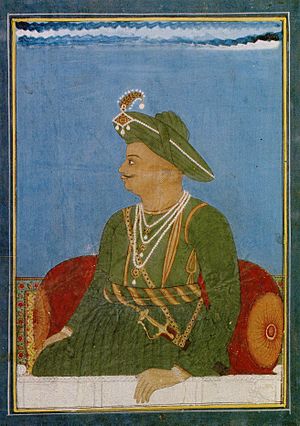
Travancore was a kingdom Tipu Sultan wanted to control. His attempts in 1788 failed. The British leader in Madras, Archibald Campbell, warned Tipu that attacking Travancore would mean war with the Company. The ruler of Travancore also upset Tipu by building forts into land that Mysore claimed. He also bought two forts from the Dutch that were in a state that paid tribute to Tipu.
In 1789, Tipu Sultan sent his forces to the Malabar Coast to stop a rebellion. Many people ran away to Travancore and Cochin for safety. To follow them, Tipu gathered troops in Coimbatore to attack the Nedumkotta. This was a strong line of defense built by Travancore's ruler. Cornwallis saw this and warned that an attack on Travancore would lead to a strong British response. Tipu likely thought it was a good time to attack because the new British leader, John Holland, was not as experienced as the previous one.
Early Battles
First Attack on Nedumkotta
On December 29, 1789, Tipu led 14,000 soldiers and attacked Nedumkotta. But Tipu's forces were defeated by the Travancore army, who caused heavy losses and pushed them back. While Tipu's army regrouped, Governor Holland tried to talk to Tipu instead of preparing for war. Cornwallis was very unhappy about this.
Medows' Campaign in 1790
It took until May for General William Medows to be ready to march. Meanwhile, Tipu attacked Travancore again and broke through the Nedumkotta line in April 1790. However, the Travancore army retreated and prepared to fight again. Heavy monsoon rains stopped Tipu's army from crossing the river. When Tipu heard that the British were preparing a big attack from Madras, he pulled back from Travancore.
Medows planned a two-part attack. The main attack would be on the Coimbatore district, and another attack would come from the northeast of Mysore. Cornwallis wasn't happy with this plan because of the monsoon season and the long supply lines needed.
Medows left Trichinopoly in late May. His progress was slow due to bad weather and equipment problems. Tipu had moved his main forces to the Mysore highlands, so Medows faced little resistance. On July 21, Medows entered Coimbatore without a fight. He had already taken smaller forts in the area. His only opposition was 4,000 cavalry under Sayed Sahib, who tried to bother his operations. Medows' cavalry eventually pushed them back. Other strong forts like Palghat and Dindigul were captured after some fighting.
Even though Medows took control of the Coimbatore district, he had to split his forces to hold it. The biggest groups were in Coimbatore, Palghat, and Sathyamangalam. The attacks from Bengal and Bombay were slow to start, which allowed Tipu to counterattack.
Tipu's Counterattack
On September 2, Tipu left Srirangapatnam with an army of 40,000 men. He moved towards Sathyamangalam. The 2,800 soldiers there fought off Tipu's first attack on September 13. But their commander, Captain John Floyd, decided to pull back. They crossed the Bhavani River at night and headed for Coimbatore. Tipu, slowed by heavy rains, sent 15,000 cavalry to chase them. These cavalry caught up and took much of Floyd's supplies.
That evening, Tipu's full army attacked them as they camped at Cheyoor. The infantry fought bravely and pushed back repeated attacks. Only when Medows sent reinforcements were they saved.
Tipu then started attacking British supply lines and communications. In early November, he tricked Medows by moving most of his army north to attack a smaller British force from Bengal. This force, about 9,000 men led by Colonel Maxwell, had built strong defenses at Kaveripattinam. Tipu couldn't break through and pulled back on November 14 when he learned Medows was chasing him again.
Medows and Maxwell joined forces on November 17. They chased Tipu, who decided to move towards Trichinopoly. Tipu could only loot the town before Medows arrived. Then, Tipu went on a rampage through the Carnatic region, destroying towns and taking supplies. He ended up at a French outpost in Pondicherry, hoping the French would help him fight the British. But France was in the early stages of its revolution, so his efforts failed. Medows then moved towards Madras, where he gave command of his army to Lord Cornwallis.
Allied Armies Advance
In the summer of 1790, a Maratha army of about 30,000 men, with some British troops, marched towards Mysore. Many Mysorean outposts surrendered quickly. The army slowly moved forward until it reached Darwar in September. The fort was under siege for 29 weeks and finally surrendered on April 3, 1791. The army then continued to advance.
A second army, with 25,000 cavalry and 5,000 infantry, left Poona in January 1791. They reached Kurnool without much trouble. This army joined Cornwallis on May 28 after he captured Bangalore.
The Nizam's army attacked Koppal in October 1790. They had poor cannons, so the siege lasted until April 1791.
British Take the Malabar Coast
British forces took control of the Malabar Coast in late 1790. One force won a big victory at Calicut in December. Another force defeated Tipu's army at Cannanore a few days later.
Nawab of Savanur Loses Land
The Nawab of Savanur lost his lands to the Maratha Confederacy. These events caused some distrust between the British and the Marathas.
First Push Towards Seringapatam
Cornwallis's first goal was to take Bangalore. This would give him a base to attack Seringapatam, Tipu's capital. He hoped this would make his allies more active. Cornwallis expected Tipu to burn everything in his path in Mysore, so he made sure to have plenty of supplies. He even brought many elephants to help carry supplies and heavy weapons.
Cornwallis took command of the main British army on January 29, 1791. A week later, he marched west. This made Tipu leave Pondicherry and rush to Bangalore, where he thought his family was in danger. Cornwallis tricked Tipu by changing direction and crossed the mountains on February 21 without any opposition. He continued to advance and reached Bangalore on March 5. Tipu had fortified the city, but he stayed with his main army outside as Cornwallis began the siege. After six weeks, during which the British had to fight off Tipu's attacks, they successfully stormed the city's fort.

After taking Bangalore, Cornwallis moved his army north to meet a supply caravan and the Nizam's army. They met on April 12. Cornwallis found the Nizam's soldiers not very helpful. He had hoped they would help fight Tipu's cavalry, but they were more interested in looting and using the army's supplies.
The British then worked to secure the area around Bangalore before moving to Seringapatam. When Cornwallis was looking for a place to cross the Cauvery River, Tipu offered battle near the village of Arakere. In the battle on May 15, Cornwallis outmaneuvered Tipu's forces and made him retreat behind Seringapatam's walls.
Since the Maratha forces were not nearby, and it seemed unlikely that Abercromby would arrive with his forces, and his army was running out of food, Cornwallis made a difficult decision on May 22. He decided to destroy his siege equipment and retreat. Just three days later, the Maratha army arrived. Tipu had successfully stopped most of their messages from reaching Cornwallis.
Cornwallis's retreat to Bangalore left the Coimbatore district open to Tipu's forces. On June 11, 2,000 Mysorean soldiers attacked Coimbatore. Lieutenant Chalmers, the commander there, chose to fight even though he had fewer than 300 men and poor gunpowder. He defended bravely, and reinforcements helped him capture the attackers' supply train in August. Eight thousand more Mysorean soldiers arrived, but Chalmers held out until November 6. However, Tipu broke the surrender terms, and Chalmers and his men were taken prisoner.
Second Push Towards Seringapatam
After the allies retreated to Bangalore, the armies of Purseram Bhow and Teige Wunt left the main army to gain land in Mysore's northern areas. Purseram Bhow wanted to take back the Bednore district. He captured Hooly Honore and Shimoga, with British help. He only stopped short of attacking Bednore itself because a part of Tipu's army was coming. Bhow did not return to the main army until peace talks began.
Cornwallis spent the rest of 1791 securing his supply lines to Madras. He attacked Nundydroog in November and Savendroog in December, both of which fell easily. He also organized a huge supply operation to make sure his army and his allies had enough food and pay. Spies were sent into Tipu's camps, and Cornwallis started getting better information about Tipu's army.
Relations between Cornwallis and his allies were difficult. The Maratha military leaders had to be bribed to stay with the army. Cornwallis said the Hyderabad forces were more of a problem than a help. One British observer called them a "disorderly rabble."
On January 25, Cornwallis moved from Savendroog towards Seringapatam. Abercromby also advanced from the Malabar Coast again. Tipu's men bothered the column but didn't stop its progress. Cornwallis set up a line of outposts to protect his supply line from Bangalore. When the huge army reached the plains outside Seringapatam on February 5, Tipu's forces began firing rockets at them. Cornwallis responded with a night attack to push Tipu out of his positions. After a somewhat confusing battle, Tipu's forces were outflanked, and he retreated into the city. Cornwallis then began the siege. On February 12, Abercromby arrived with the Bombay army, and the pressure on Tipu increased. By February 23, Tipu started asking for peace talks. Hostilities stopped the next day when he agreed to initial terms.
Peace Treaty
One of Cornwallis's main conditions for peace was that Tipu had to give two of his sons as hostages. This was a guarantee that he would follow the peace terms. On February 26, his two young sons were formally given to Cornwallis with a big ceremony and gun salutes from both sides. Cornwallis didn't want to take too much land for the British or give most of Mysore to the Marathas and Hyderabad. He negotiated a deal where half of Mysore's territory would be divided among the allies. The British gained land that improved their defenses. He later wrote that if they had taken Seringapatam and killed Tipu, they would have faced difficult choices about who would rule Mysore. Mysore also had to pay some of the war costs.
On March 18, 1792, Tipu agreed to the terms and signed the Treaty of Seringapatam, which ended the war.
What Happened Next
The war greatly reduced the size of Mysore. The Marathas, the Nizam of Hyderabad, Travancore, and the Madras Presidency all gained land. Districts like Malabar, Salem, Bellary, and Anantapur were given to the Madras Presidency.
A fourth and final war happened between the British and Mysore in 1799. In this war, Seringapatam was captured, and Tipu Sultan was killed defending it. The winners sent Tipu's family away and gave control of Mysore back to the Wadiyars.
One important military idea Tipu Sultan used was mass attacks with rocket brigades. These were called cushoons. The rockets used by these groups impressed the British so much during the Third and Fourth Mysore Wars that William Congreve was inspired to create his own Congreve rockets.
Cornwallis was given the title of Marquess for his actions in the war. The Indian soldiers who fought under his command received the Mysore Medal.
|


